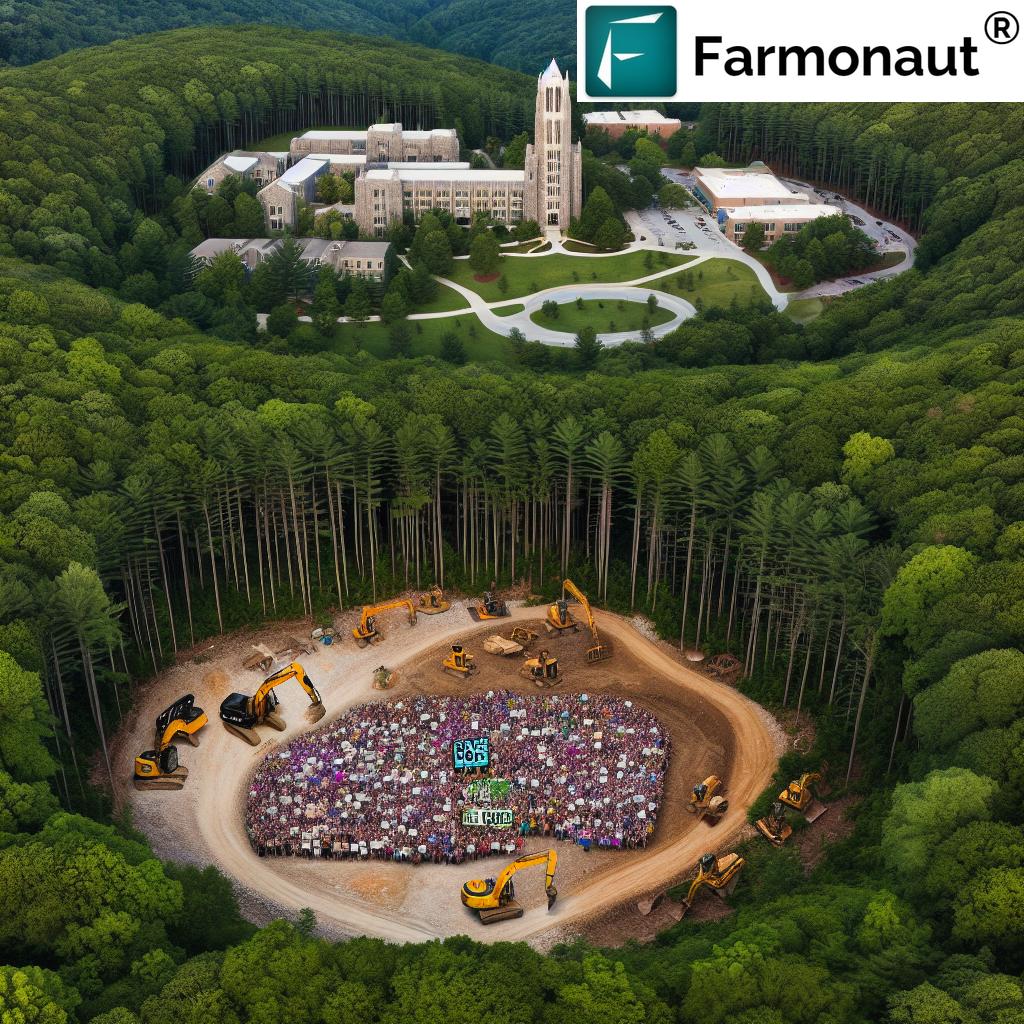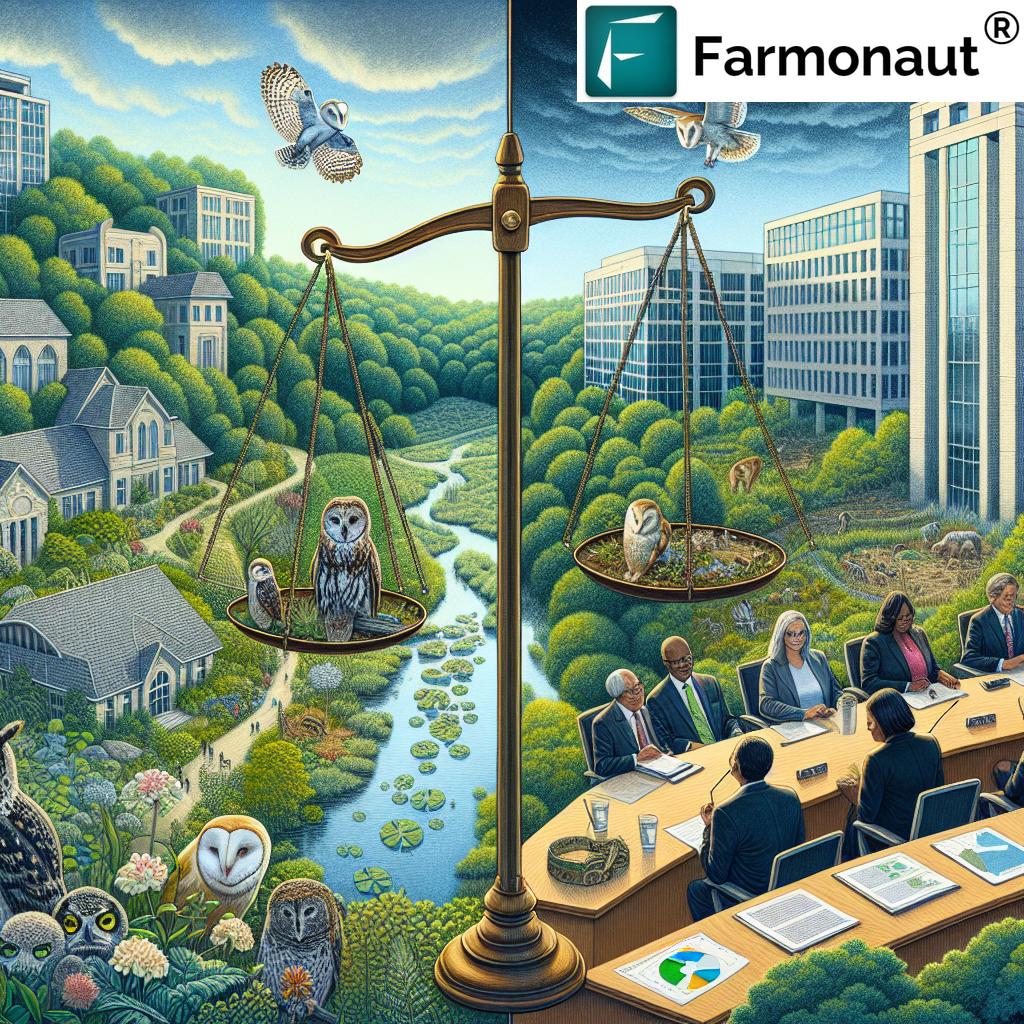Preserving Urban Green Spaces: Asheville’s Community Unites to Save University Woods
“Asheville’s ‘Save the Woods’ campaign gathered thousands of signatures to protect a 45-acre urban forest from potential development.”
In the picturesque city of Asheville, North Carolina, a fervent battle is unfolding between urban development and environmental conservation. At the heart of this controversy lies a 45-acre wooded property on the University of North Carolina at Asheville (UNCA) campus, affectionately known as the “experimental forest” by local residents. This verdant oasis has become the focal point of a community-driven campaign to preserve one of the city’s remaining urban green spaces, highlighting the delicate balance between progress and preservation in growing communities.
The Unfolding Controversy
The spark that ignited this passionate community response was the university’s announcement of an exploratory assessment of the wooded property. On January 16, UNCA released a statement detailing plans for soil boring and sampling, along with necessary land surveying. However, the extent of the work quickly raised alarms among neighbors who observed excavator tracks, boreholes, and cut vegetation while walking the familiar trails.
Starr Silvis Metcalf, a long-time resident and environmental engineer, expressed her dismay at the visible changes in the woods. “These aren’t just trees,” she remarked, “they’re the lungs of our neighborhood and a critical habitat for local wildlife.” Her sentiments echo the deep emotional connection many in the community feel towards this green space, which has been a sanctuary for generations of families and a haven for diverse flora and fauna.

Community Response and the “Save the Woods” Campaign
As news of the assessment spread, the Asheville community quickly mobilized. What began as a small group of concerned citizens rapidly evolved into a full-fledged movement. The “Save the Woods” campaign, initially comprising just 10 members, saw its ranks swell to over 2,600 supporters in a matter of weeks. This grassroots effort exemplifies the power of community action in the face of perceived environmental threats.
A petition to preserve the forest garnered more than 6,800 signatures, demonstrating the widespread support for conservation. Alix Doddridge, one of the campaign organizers, emphasized the woods’ significance: “This isn’t just about saving trees; it’s about preserving a vital oasis that contributes to our community’s well-being and ecological health.”
University Stance and Community Skepticism
In response to the growing concern, the UNCA Board of Trustees issued a resolution reaffirming that the assessment was exploratory in nature and that no decisions regarding development had been made. The university’s statement on January 31 outlined that after initial soil assessments and some brush clearing, the primary task of boundary surveying would continue without further tree removal.
Despite these assurances, many residents remain skeptical. Past experiences with proposed developments on university land have fostered a sense of wariness among the community. This history of distrust has fueled calls for greater transparency and dialogue regarding the university’s land management plans.
Environmental Impact and Ecological Concerns
The controversy surrounding University Woods brings to light critical issues of urban ecology and the preservation of green spaces within growing communities. These 45 acres represent more than just a wooded area; they are a complex ecosystem supporting a diverse array of wildlife, including hawks and bears.
Environmental experts emphasize the importance of undisturbed urban forests in maintaining biodiversity, improving air quality, and mitigating the urban heat island effect. The disturbance caused by excavation and vegetation removal, even if minimal, can have far-reaching consequences on the delicate balance of this ecosystem.
The Role of Technology in Urban Green Space Preservation
As we grapple with the challenges of urban development and environmental conservation, technology plays an increasingly crucial role in finding sustainable solutions. Advanced tools for land management and environmental monitoring can provide valuable insights to inform decision-making processes.
Farmonaut, a pioneering agricultural technology company, offers satellite-based management solutions that could be adapted for urban green space monitoring. While primarily focused on agriculture, Farmonaut’s technology demonstrates the potential for using satellite imagery and AI to assess and manage urban forests more effectively.
By leveraging such technologies, cities like Asheville could gain a more comprehensive understanding of their green spaces, helping to balance development needs with conservation efforts. For instance, satellite-based vegetation health monitoring could provide regular updates on the condition of urban forests, allowing for early detection of potential issues.
Balancing Development and Conservation
The situation in Asheville underscores the broader challenge faced by growing communities worldwide: how to balance the need for urban development with the preservation of vital green spaces. This delicate equilibrium requires thoughtful planning, community engagement, and innovative approaches to land use.
Urban planners and policymakers must consider the long-term benefits of preserving green spaces against the short-term gains of development. These benefits include:
- Improved air quality and reduced urban heat island effect
- Enhanced biodiversity and wildlife habitats
- Increased property values in surrounding areas
- Mental and physical health benefits for residents
- Natural stormwater management and erosion control
“The University Woods controversy in Asheville involves a 45-acre experimental forest, highlighting urban ecology challenges in growing communities.”
Community Engagement and Transparency
The controversy surrounding University Woods highlights the critical importance of transparency and community engagement in land use decisions. Effective communication between institutions, local governments, and residents is essential for building trust and finding mutually beneficial solutions.
To address the current situation and prevent future conflicts, we recommend the following steps:
- Establish a community advisory board to facilitate ongoing dialogue between the university and residents
- Conduct public hearings and information sessions to keep the community informed of any potential plans or assessments
- Develop a comprehensive urban forest management plan with input from environmental experts and local stakeholders
- Explore conservation easements or other legal protections to ensure the long-term preservation of vital green spaces
- Implement regular environmental impact assessments and share results with the public
Learning from Other Cities
Asheville is not alone in facing the challenges of urban green space preservation. By examining similar cases from other cities, we can gain valuable insights into successful conservation strategies and potential pitfalls to avoid.
| City | Green Space Name | Size (acres) | Threat Level | Community Response | Preservation Status | Key Preservation Strategies |
|---|---|---|---|---|---|---|
| Asheville, NC | University Woods | 45 | High | Strong | Ongoing | Community campaign, petition, public advocacy |
| Portland, OR | Forest Park | 5,200 | Medium | Strong | Successful | Conservation zoning, community stewardship programs |
| Austin, TX | Zilker Park | 351 | Low | Moderate | Successful | Historic designation, public-private partnerships |
| Seattle, WA | Discovery Park | 534 | Low | Strong | Successful | Master plan implementation, habitat restoration |
| New York, NY | Fresh Kills Park | 2,200 | Low | Moderate | Ongoing | Landfill reclamation, phased development approach |
The Role of Technology in Urban Forest Management
As we consider the future of urban green spaces like University Woods, it’s crucial to recognize the potential of technology in enhancing our understanding and management of these vital ecosystems. While Farmonaut’s primary focus is on agricultural applications, the principles and technologies they employ could be adapted to urban forest management.
Some potential applications include:
- Satellite-Based Vegetation Monitoring: Regular assessments of forest health using multispectral imagery
- AI-Driven Analysis: Automated detection of changes in forest cover or signs of distress in vegetation
- Resource Management Tools: Optimizing maintenance and conservation efforts through data-driven insights
- Environmental Impact Tracking: Monitoring the urban forest’s contribution to air quality and carbon sequestration
Explore Farmonaut’s API for advanced satellite data integration
By leveraging such technologies, cities like Asheville could gain a more comprehensive and up-to-date understanding of their urban forests, enabling more informed decision-making and proactive management strategies.
Legal and Policy Considerations
The preservation of urban green spaces often involves navigating complex legal and policy frameworks. In Asheville’s case, the university’s status as a state institution adds another layer of complexity to the situation. Key considerations include:
- Zoning regulations and land use policies
- Environmental protection laws at local, state, and federal levels
- Institutional autonomy vs. community interests
- Potential for conservation easements or land trusts
- Public access rights and recreational use considerations
A thorough understanding of these legal and policy aspects is crucial for both the university and community advocates as they work towards a resolution.
Economic Implications of Urban Green Space Preservation
While the environmental and community benefits of preserving urban forests are clear, it’s also important to consider the economic implications. Studies have shown that urban green spaces can have significant positive impacts on local economies:
- Increased property values in surrounding neighborhoods
- Attraction of businesses and skilled workers to the area
- Reduced healthcare costs due to improved air quality and opportunities for physical activity
- Natural stormwater management, reducing the need for costly infrastructure
- Potential for eco-tourism and recreational activities
By quantifying these economic benefits, advocates for preserving University Woods can present a more comprehensive case for conservation.
Access Farmonaut’s API Developer Docs for detailed implementation guides
The Future of University Woods and Asheville’s Urban Ecology
As discussions continue and the community awaits further decisions from UNCA, the future of University Woods remains uncertain. However, this controversy has undoubtedly sparked a broader conversation about urban ecology and the value of green spaces in Asheville and beyond.
Potential outcomes and considerations for the future include:
- Development of a comprehensive urban forest management plan for Asheville
- Exploration of innovative land use solutions that balance development needs with conservation
- Increased community involvement in land use decisions and environmental stewardship
- Integration of advanced technologies for ongoing monitoring and management of urban green spaces
- Establishment of new policies or ordinances to protect and preserve urban forests

Conclusion: A Call for Sustainable Urban Development
The controversy surrounding University Woods in Asheville serves as a poignant reminder of the challenges facing growing communities worldwide. As we strive for progress and development, we must not lose sight of the irreplaceable value of our urban green spaces. These areas are not merely vacant lots awaiting development; they are vital ecosystems that contribute to our health, well-being, and the overall sustainability of our cities.
The passionate response from the Asheville community demonstrates the deep connection people feel to their local environments. It also highlights the power of collective action in shaping the future of our urban landscapes. As we move forward, it is crucial that we embrace a model of urban development that prioritizes the preservation and enhancement of green spaces, recognizing their integral role in creating livable, sustainable cities.
By leveraging innovative technologies, fostering open dialogue between institutions and communities, and implementing forward-thinking policies, we can work towards a future where urban development and environmental conservation go hand in hand. The story of University Woods is still unfolding, but it has already provided valuable lessons in community engagement, environmental stewardship, and the importance of preserving our urban forests for generations to come.
FAQ Section
Q: What is the current status of University Woods in Asheville?
A: As of now, University Woods is undergoing an exploratory assessment by the University of North Carolina at Asheville. No final decisions about development have been made, and the community is actively campaigning for its preservation.
Q: How large is the area under consideration?
A: The wooded property in question is approximately 45 acres in size.
Q: What is the “Save the Woods” campaign?
A: The “Save the Woods” campaign is a community-led initiative aimed at preserving University Woods. It has gathered thousands of signatures and has grown from 10 to over 2,600 members in just a few weeks.
Q: What are the main concerns of the community regarding the university’s assessment?
A: The community is primarily concerned about potential development of the woods, loss of wildlife habitat, and the impact on local ecology and quality of life.
Q: How has the university responded to community concerns?
A: The university has stated that the assessment is exploratory and that no development decisions have been made. They have also committed to minimizing disturbance during the assessment process.
Q: What role can technology play in urban forest preservation?
A: Advanced technologies like satellite imaging and AI-driven analysis can help monitor forest health, track changes over time, and provide data-driven insights for better management and conservation of urban green spaces.
Q: How do urban forests benefit communities?
A: Urban forests provide numerous benefits, including improved air quality, reduced urban heat island effect, enhanced biodiversity, increased property values, and mental and physical health benefits for residents.
Q: What can individuals do to support urban green space preservation?
A: Individuals can get involved by signing petitions, attending community meetings, volunteering for local conservation efforts, and advocating for policies that protect urban forests.
Explore Farmonaut’s Solutions
While Farmonaut’s primary focus is on agricultural applications, their innovative approach to land management and environmental monitoring offers valuable insights for urban green space preservation. Explore their solutions to learn more about the potential of technology in environmental conservation:
Earn With Farmonaut: Affiliate Program
Earn 20% recurring commission with Farmonaut’s affiliate program by sharing your promo code and helping farmers save 10%. Onboard 10 Elite farmers monthly to earn a minimum of $148,000 annually—start now and grow your income!
















